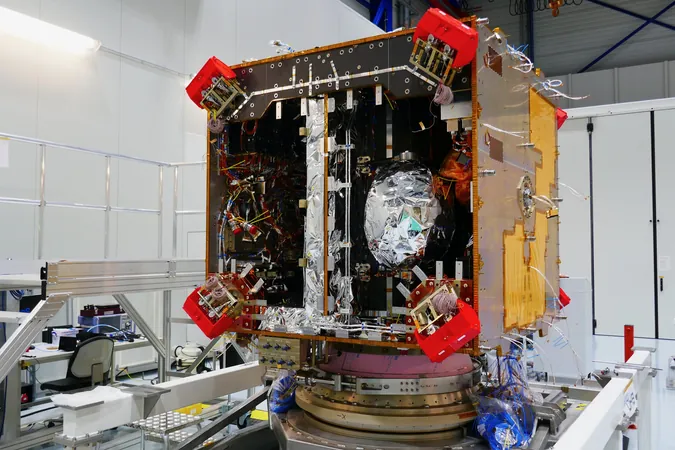
Hera's Groundbreaking Leap Towards Mars: A Giant Step in Planetary Defense!
2024-11-08
Author: Rajesh
The European Space Agency's (ESA) Hera mission is making waves as it embarks on an ambitious journey to the Didymos binary asteroid system. Having launched on October 7, 2023, Hera recently completed a critical set of maneuvers that will set the stage for an unprecedented exploration of asteroids.
On October 23, Hera executed its first deep-space maneuver, firing its three orbital control thrusters for an intense 100 minutes. This action altered its velocity by approximately 146 meters per second. The mission team followed up with a second burn on November 6, which lasted 13 minutes aimed at providing an additional boost of around 20 meters per second. Together, these crucial maneuvers have successfully placed Hera on a trajectory that will enable it to harness a gravity assist from Mars, scheduled for March 2025.
Sylvain Lodiot, Hera's Spacecraft Operations Manager, elaborated on the maneuvers, stating, "Deep-space maneuvers are often split into parts. The first, larger burn accomplishes the majority of the work, while the second burn fine-tunes any inaccuracies." This meticulous approach is crucial for ensuring the spacecraft reaches its destination safely and efficiently.
Following the launch, ESA's control team at the European Space Operations Center (ESOC) in Germany conducted three successful test burns. Utilizing powerful deep-space radio dishes in Spain, Argentina, and Australia, the team tracked Hera's journey and precisely measured its velocity at each stage.
According to Francesco Castellini from ESOC's Flight Dynamics team, analysis of Hera's new trajectory following the second burn looks promising. A minor correction maneuver is scheduled for November 21 to optimize the spacecraft's path for the Mars flyby ahead.
Mars is playing a pivotal role in Hera's mission, and ESA's Mission Analysis team underscores the fortunate alignment of planetary positions that will allow Hera to use Mars’ gravity to accelerate towards Didymos. This not only saves valuable fuel but also enables Hera to arrive at the asteroids several months earlier than anticipated.
In addition to its main mission objectives, Hera will take advantage of this Mars flyby to conduct opportunistic science. The carefully plotted trajectory will bring the spacecraft within just 300 kilometers of Deimos, Mars' enigmatic moon, providing a unique opportunity for scientific observation.
Set to embark on a second deep-space maneuver in February 2026, Hera's journey toward Didymos will include a sequence of rendezvous maneuvers from October to December 2026. Once at Didymos, Hera aims to address fundamental questions about binary asteroid systems, including their formation, the impact consequences of NASA's DART mission which struck Didymos’ moonlet Dimorphos in 2022, and the internal structure of Dimorphos itself.
But the excitement doesn't end there! With Hera's successful launch, ESA is simultaneously ramping up efforts on its second asteroid mission, Ramses, which aims to study asteroid Apophis. The agency's Near-Earth Object Coordination Center is also actively tracking and analyzing new asteroid discoveries while recently leading the identification of an asteroid predicted to make a close approach to Earth.
As ESA continues to expand its reach in planetary defense, experts will convene at ESOC next week, discussing enhanced strategies for measuring potentially hazardous near-Earth asteroids. The future looks bright for asteroid explorations! Stay tuned for more exciting developments in the realm of space exploration!




 Brasil (PT)
Brasil (PT)
 Canada (EN)
Canada (EN)
 Chile (ES)
Chile (ES)
 España (ES)
España (ES)
 France (FR)
France (FR)
 Hong Kong (EN)
Hong Kong (EN)
 Italia (IT)
Italia (IT)
 日本 (JA)
日本 (JA)
 Magyarország (HU)
Magyarország (HU)
 Norge (NO)
Norge (NO)
 Polska (PL)
Polska (PL)
 Schweiz (DE)
Schweiz (DE)
 Singapore (EN)
Singapore (EN)
 Sverige (SV)
Sverige (SV)
 Suomi (FI)
Suomi (FI)
 Türkiye (TR)
Türkiye (TR)